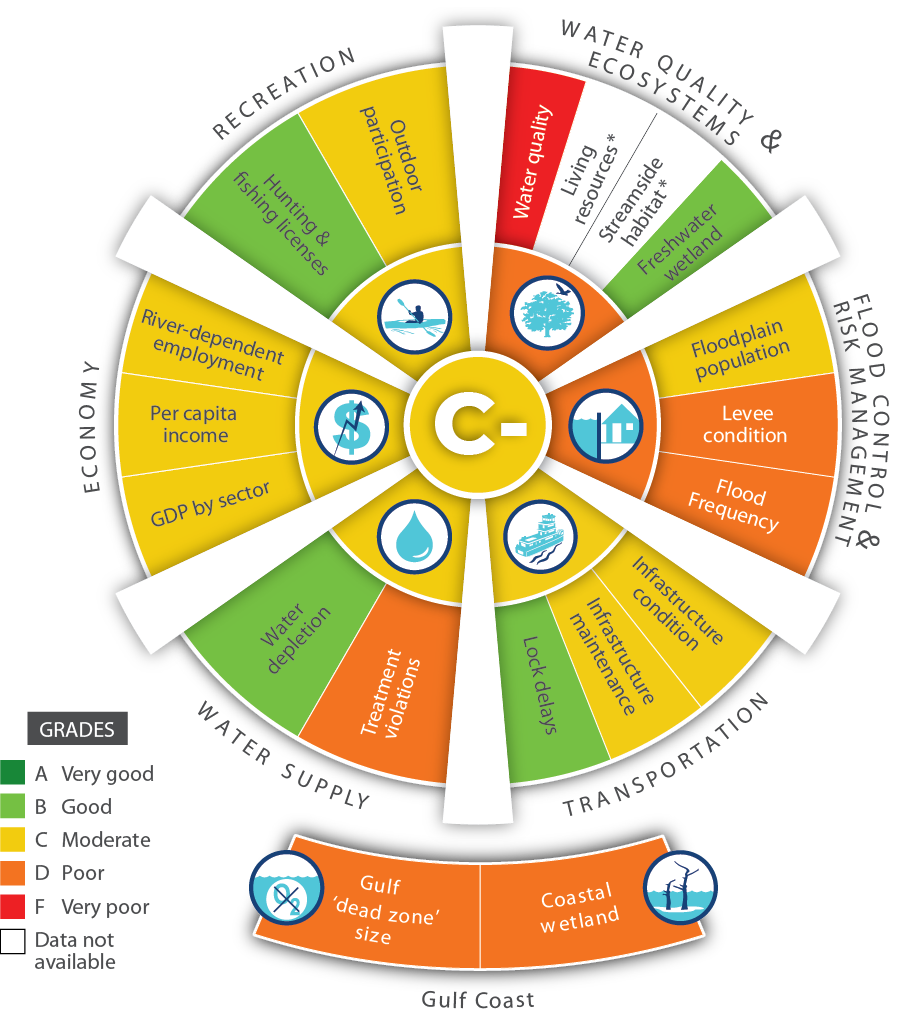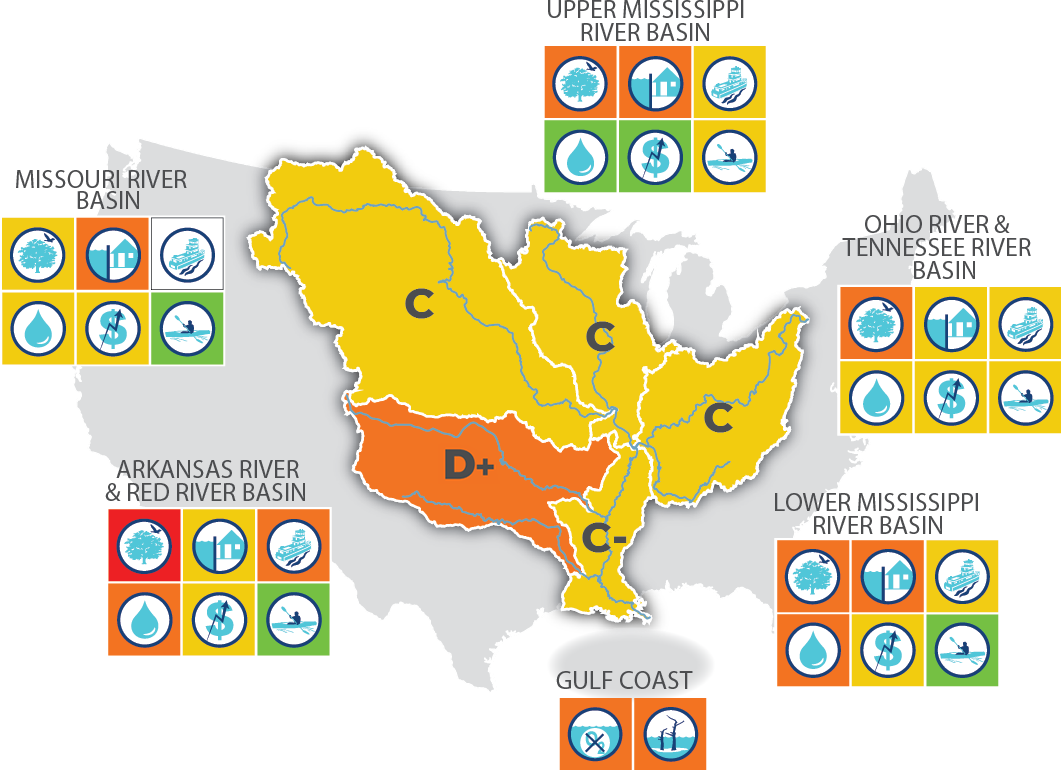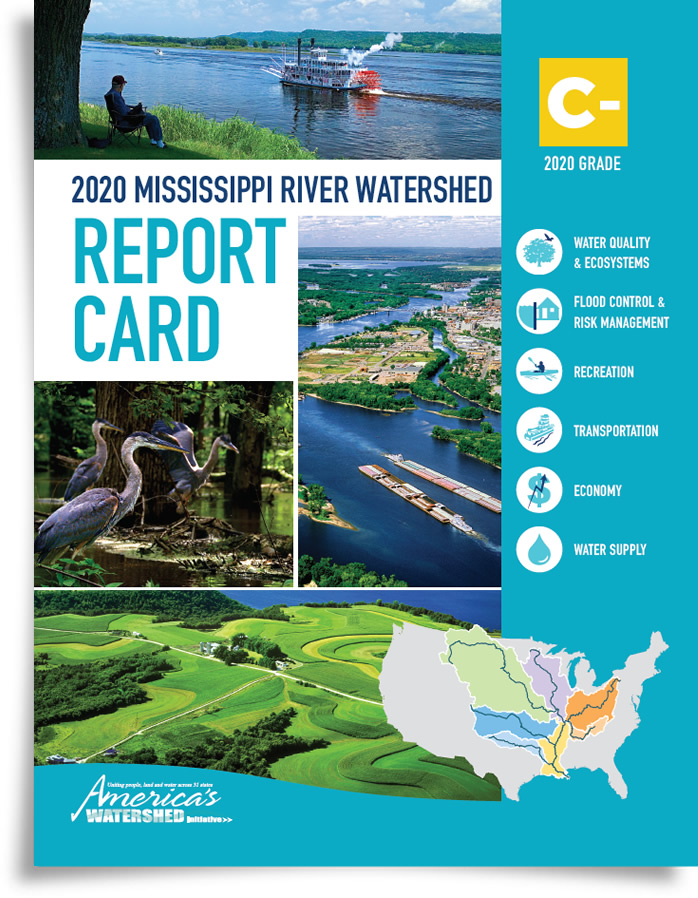The 2020 Mississippi River Watershed Report Card
AWI’s 2020 Mississippi River Watershed Report Card grades the overall watershed with a C-.2020 Mississippi River Watershed Report Card
The 2020 Mississippi River Watershed Report Card marks progress toward restoring the health and condition of the Mississippi River Watershed and its basins.
Borrowing the traditional form of a school report card, AWI’s 2020 Mississippi River Watershed Report Card grades the overall watershed with a C-.
This grade – a modest improvement over the D+ earned in AWI’s 2015 report card – represents the productivity of the watershed with regards to economic activity and environmental resilience.
The 2020 Mississippi River Watershed Report Card describes progress toward achieving the goals established in the 2015 report card, highlights some of the important work that partners across the watershed are doing to make positive change, and documents the work and investment that remains.
2020 Report Card Takeaways:
- The 2020 report card saw modest improvements in the following indices: hunting and fishing licenses, floodplain population, and infrastructure maintenance and condition.
- The watershed remains threatened by more frequent and extreme flooding, aging infrastructure, chemical pollution, nutrient runoff, and continued urbanization and agricultural intensification.
- The river’s water quality is rated as very poor, with concerns for the nation’s drinking water supply, resulting in the grade for water supply and ecosystems dropping to a D compared to 2015.
- Flood control and risk reduction remains an urgent area of concern, with the grade of D unchanged since 2015.
Grades at a Glance
Click on the ‘paddlewheel’ below to explore grades for each of the six Report Card Goals.

Recreation
GOAL: Provide world-class recreation opportunities: Enrich the quality of life for people and recreation-based economies by maintaining and enhancing riverine, lake and wetland-associated recreation within the basin.
2020 GRADE: C+
Water Quality & Ecosystems
GOAL: Support and enhance healthy and productive ecosystems: Conserve, enhance and restore ecosystems within the Mississippi River Watershed to support natural habitats and the fish and wildlife resources that depend upon them.
2020 GRADE: D
Flood Control & Risk Management
GOAL: Provide reliable flood control and risk reduction Provide reliable flood protection and risk reduction through well managed and maintained infrastructure, including appropriate floodplain connections for water conveyance and ecosystem benefits, and management of surface and storm water runoff to better protect life, property and economies.
2020 GRADE: D+
Economy
GOAL: Support local, state and national economies: Sustain a water use system to efficiently and effectively support agricultural, industrial and energy productivity.
2020 GRADE: C
Water Supply
GOAL: Maintain supply of abundant clean water: Ensure the quality and quantity of water in the Mississippi River Basin is adequate to support the economic, social and environmental functions that are dependent on it.
2020 GRADE: C
Transportation
GOAL: Serve as the nation’s most valuable river transportation corridor: Provide for safe, efficient and dependable commercial navigation within the Mississippi River Watershed to ensure a competitive advantage for our goods in global markets.
2020 GRADE: C
* Data from the US EPA Rivers and Streams Assessment to update scores for Living Resources and Streamside Habitat is not yet publicly available. When this data becomes available, an electronic update will be posted here.
Explore Report Card by Basin
Click on the map below to explore grades for each of the five Sub-Basins.

Missouri River Basin
Improved scores for Freshwater Wetland, but has increasing trends in frequency of floods. Levee Condition is poor and Per Capita Income is relatively low in the region.
2020 GRADE: C
Upper Mississippi River Basin
Water quality is poor, as a result of high nutrient runoff from regional agriculture. Frequency of floods is increasing, likely a result of rainfall increases and drainage modifications. Lock delays remained low when compared to historical data, reflecting ongoing maintenance efforts to keep old infrastructure operational.
2020 GRADE: C
Arkansas River & Red River Basin
Poor scores for Freshwater Wetland, Levee Condition, Lock Delays, Treatment Violations, and Per Capita Income result in a low overall score for the basin. Although the average age of locks is the lowest of all basins, they still need rehabilitation.
2020 GRADE: D+
Ohio River & Tennessee River Basin
Conditions are driven by high nutrient inputs, increasing frequency of floods, and improvements in infrastructure. Per Capita Income is relatively low in some areas.
2020 GRADE: C
Lower Mississippi River Basin
Affected by all the basins upriver, nutrient loads are high, but Flood Frequency scores are good, especially in the tributaries and streams. Transportation scores improved with increased funding for dredging and infrastructure maintenance.
2020 GRADE: C-
Gulf Coast
The average size of the Gulf Dead Zone since 2015 is still almost three times as large as the Gulf Hypoxia Task Force target, and the historical loss of coastal land in Louisiana is an ongoing issue despite efforts to rebuild it.
2020 GRADE: D

